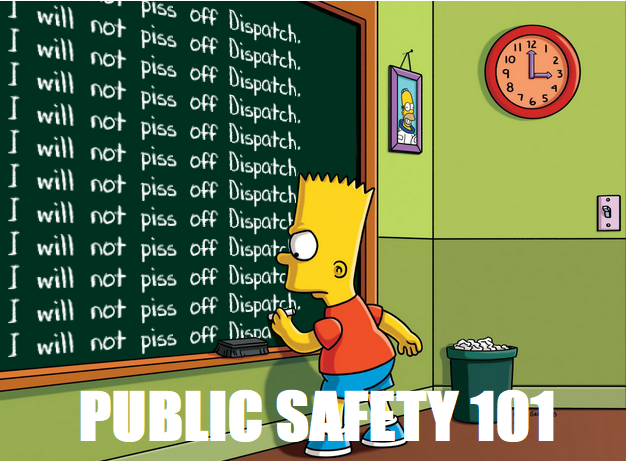If I had six hours to chop down a tree, I’d spend the first four hours sharpening the axe.
February was a somewhat eventful month for emergency situations – one in our backyard, one in a place that could be our backyard, and one that portends of future challenges that may require significant changes.
These presented unique challenges that range from temporary inconveniences to significant disruption and outright danger. Let’s take a closer look through a local lens.
Myrtle Hill Fire Presents Special Challenges, Traffic Concerns, Media Questions, Political Silence?
The afternoon of February 1 was a relatively sedate day off for me until the fire siren sounded just before 3 PM. I started listening to the radio and when I heard the address, I went outside and looked on the hill above the borough building /fire station. Smoke was already visible.
It didn’t take long for the first fire official – Sewickley’s fire chief – to arrive on scene, provide an initial size-up, and assume Incident Command. He instructed that just two fire vehicles – an engine (pumper) and a ladder truck – would be permitted at the house to attack the fire. All other responding crews would leave their vehicles on Camp Meeting Road and walk into the fire scene.

Myrtle Hill Road coming in from Camp Meeting Road. 20 Myrtle Hill can be seen in the upper right corner. Click to enlarge. – Google Maps

Emergency vehicles staged along Camp Meeting Road at the Myrtle Hill intersection. – Fair Oaks VFD via Facebook
This appears to be due in part to the nature of Myrtle Hill Road itself – a winding, single-lane communal driveway – and the location of the closest fire hydrant, along Camp Meeting Road just above the Myrtle Hill intersection. Large-diameter supply hose would also be occupying the narrow roadway.
This staging of vehicles necessitated the closure of Camp Meeting between Beaver Road and Pilgrim Drive at perhaps the busiest part of the day, involving school dismissal and the beginning of afternoon rush hour.
Per multiple accounts from firefighters at the scene and other sources, the fire started in the kitchen and stubbornly worked its way into the walls and between floors of the over 4,000 square foot house, built in 1890 according to county property records.
Within an hour, flames were through the roof. It would be another two hours before the fire was reported to be mostly under control.
Shortly after fire units were on scene, I noticed a media helicopter in the area. While walking the dog with my wife I was able to identify it as the WTAE Channel 4 aircraft. It arrived about 15 minutes after the fire call was dispatched, and remained in the area for about 15 additional minutes.
Because of the hilltop location and clear weather conditions, the fire was visible from across the local area, likely drawing the initial media attention. When I got home, video from above the scene was a teaser for the Channel 4 newscast at 4PM, and was included as one of the lead stories. WPXI also had a very short blurb about the fire, with a very short, distant video.
Even with the initial airborne reporting, I found the lack of media coverage to be a little strange, considering the visibility of the incident along with the disruption caused by the associated road closure. Channel 4 did not follow up with any additional coverage, and the story and video essentially disappeared – it is not available on their website, and they did not respond to an email requesting its location or availability.
The local print media appeared to follow suit, with nary a whiff of coverage from the Sewickley Herald / Trib, Post-Gazette, or Beaver County / Allegheny Times.

Graphic showing the location of the Myrtle Hill Rd. fire, the closest water supply, and where emergency vehicles were staged. Included are the road closure points at Pilgrim Dr. and Beaver Road, and the proposed location of the new QVHS. – Allegheny County GIS / J. Linko
I’m imagining an incident such as this occurring at the same time of day, only with buses, parents, and students attempting to enter / exit a new Quaker Valley High School.
It’s likely that a fire incident commander, working in concert with both Leet Township and QVSD Police, would have to try and find a workaround to permit access to/from the high school while restricting traffic through the fire zone.
Adding to the complex nature of such a scenario is the student and staff movement from the Watson Institute and Encompass Rehab – given the limited detour options, the commitment of manpower to facilitate traffic control may also present a daunting challenge in a possibly resource-scarce response environment.
Dave Volk, Leet Township’s Emergency Management Coordinator, sees these concerns as a problem manifesting itself in the present, as well as in the near possible future.
Contacted in late February, Mr. Volk stated his ongoing concerns about the need for a secondary means of access to the proposed high school campus, and stated his opinion that the original driveway from Little Sewickley Creek Road (the Edgeworth side) was a viable alternate. He also opined that cost and perceived regulatory challenges were likely contributing factors to the school district deciding not to pursue its development.

Full-page ad in November 3, 2022 Sewickley Herald, placed by Citizens for a Great School. Click to Enlarge.
I asked him about the letter he and other emergency officials submitted to the Leet Zoning Hearing Board regarding the new high school site. He was displeased that this letter was appropriated from public records by Citizens For a Great School (CGS) as part of their campaign against the new high school site.
The letter asserts many of the concerns about access in/out of the proposed campus, including the perception that QVSD did not consult with local public safety and emergency stakeholders when planning the proposed facility.
Mr. Volk also stated that he organized and hosted an informational meeting for police and fire chiefs and Emergency Management Coordinators for all Quaker Valley municipalities and Ohio Township.
Aside from those in the immediate area of the proposed school site, the meeting was sparsely attended. He suggested that many municipal stakeholders may be unwilling to weigh in due to the politically charged nature of the project, and/or the opinions of their respective elected officials.
Mr. Volk added that current traffic on Camp Meeting during the traditional “rush hour” periods on weekdays was already significant without the addition of a new high school.
Fair Oaks VFD Chief Nathan Turner did not respond to an e-mail seeking comment.
This incident is just one more example of the critical role that Camp Meeting Road plays in the movement of people and services to/from schools, health care facilities, and numerous private residences. While there are detour routes available, they are often less than optimal in both proximity and condition, and can add precious minutes to an emergency response.
Stakeholders in this roadway’s continued upkeep and maintenance, from Allegheny County on down, need to recognize this critical role and incorporate it into processes designed to keep the road open and accessible whenever possible.
We’ll see how this works in as the high school project moves toward its upcoming encounter with the Leet Township Planning Commission.
We Are All East Palestine…
The February 3 train derailment and hazardous materials release in nearby East Palestine, Ohio has been a consistent part of the regional and national news cycle since its occurrence.
It has also become fodder for all manner of political maneuvering and potentially confusing information, with stories designed to appear like hard news but with a decided slant toward an agenda (environmental, regulatory, anti-government) being pushed into social media. This includes all manner of online commentary that really wasn’t all that constructive. One exception to this was Robert Reich, who was thorough, concise, and to the point.
Another source of seemingly solid information came from our new Governor, Josh Shapiro. In a strongly worded letter to Norfolk Southern’s CEO, he outlined several observations by Pennsylvania officials on scene, including the following –
Norfolk Southern failed to implement Unified Command, creating confusion and resulting in a general lack of awareness for first responders and emergency management of the tactics Norfolk Southern planned in response. Early in the incident, Norfolk Southern personnel separated themselves from the rest of the incident management structure at the Incident Command Post to conduct separate operational and tactical planning, forcing state and local response agencies to react to tactics that were developed unilaterally and without the combined input of key state agencies.
As citizens and residents who also have Norfolk Southern as a presence in their respective communities, it’s incumbent upon us to ask questions of both our government and ourselves as to how we would manage a similar situation.
Gazette 2.0 looked into the potential impact of such an incident in their coverage area (Coraopolis / McKees Rocks), but came up with as many questions as they did answers. The Beaver County Times also reported today on this activity, but it’s hidden firmly behind their subscription paywall.
The train that derailed just outside of East Palestine, and just short of the PA border, was destined for the large NS switching yard in Conway, not very far north of the Quaker Valley. Where it was destined from there is unknown, but it’s within the realm of possibility that some or all of the train could have eventually been headed south through our area.

A one-mile radius from a hypothetical incident at the Maruca Overpass in Leetsdale – this zone is the same as the original evacuation zone around East Palestine. Click to enlarge – Allegheny County GIS / J. Linko
The above graphic shows the impact of the initial evacuation of East Palestine – a one mile radius from the scene – if a similar evacuation was called for an incident in Leetsdale. The affected areas to be evacuated include the entire borough of Leetsdale, the Fair Oaks and Quaker Heights areas of Leet Township, the Route 51 (McGovern Boulevard) section of Crescent Township, and southern portions of Ambridge, Harmony Township, and South Heights in Beaver County.
Many Leetsdale residents may already be familiar with evacuation procedures from the 2015 Lubrizol fire in the Leetsdale Industrial Park. This incident required the evacuation of the industrial and residential areas between the railroad and the Ohio River, and a shelter-in-place order for surrounding communities.
Remarkable with this incident, which I wrote about not long afterward, are two important factors in any evacuation scenario that remain newsworthy in this context –
- A secondary evacuation route from the Industrial Park / Buncher / Washington Street neighborhood, in the event the sole point of ingress and egress, the Maruca Overpass, is compromised by something like, you know, a train derailment.

Big Sewickley Creek and bridges between two industrial areas. Click to enlarge – Google Maps / J. Linko
Through conversation with borough engineer Dan Slagle and reviewing Council meeting minutes, I know that establishing a route through the Hussey Copper property and across Big Sewickley Creek into the Port Ambridge Industrial Park (where there is another bridge across the tracks) has been an ongoing project since the Lubrizol incident.
Hopefully the heightened awareness of the potential for an emergency in the wake of East Palestine will help to move the process along.
- The proper use of a community alerting system, absent for the Lubrizol evacuation due to an incomplete rollout of authorized users and procedures, is also in flux this year, in apparent response to some corporate mergers and acquisitions, with accompanying upgrades in available technology.
Seems that SwiftReach Solutions, the current provider of Leetsdale’s alerting system, was absorbed in 2018 by Rave Mobile Safety. This past December, Rave was acquired by Motorola Solutions, a legacy powerhouse in the provision of technology and integrative solutions for public safety and government.
Leetsd ale Council last week authorized the incorporation of the Rave Alert application to accomplish these notifications in the future. Hopefully this upgrade of borough operations will follow best practice methodologies to assure both its availability as a viable resource on a 24/7/365 basis, and its ability to rapidly deliver information that is carefully crafted to be relevant, actionable, and understandable by the majority of the citizens it is intended to reach.
ale Council last week authorized the incorporation of the Rave Alert application to accomplish these notifications in the future. Hopefully this upgrade of borough operations will follow best practice methodologies to assure both its availability as a viable resource on a 24/7/365 basis, and its ability to rapidly deliver information that is carefully crafted to be relevant, actionable, and understandable by the majority of the citizens it is intended to reach.
Alerting technology is something that will not be effective without development of a best practice for its operation – one that addresses the technology itself, the processes that govern activation, and properly orienting / training people about both. Procedures about who can activate, for what, and the content of any alert message need to be in place before the app goes live, and should be tested periodically to assure its continued effectiveness.
Citizens still have their own responsibilities to consider when/if their area of residence or employment is subject to an evacuation or disaster, and resources for making oneself prepared are in abundance online, at both the federal and state level. These and other private sources offer advice, and in some cases actual materials, suitable for putting together supplies for emergencies, whether in a shelter-in-place or evacuation scenario.
All municipalities in Pennsylvania are required to have an appointed Emergency Management Coordinator, who is charged with taking a leadership role in planning for these types of incidents, along with assuring that resources at the county and state level are notified / mobilized as the law requires.
A list of those so appointed in Allegheny County is available here.
We in the Quaker Valley need to remember that the major transportation pathways that traverse our area – be it rail, highways, or overhead – carry with them the capability to significantly disrupt our lives and the viability of our community.
We need to maintain focus on keeping ourselves prepared locally, while lobbying our elected officials to keep the pressure on for safety regulations that are consistently and competently enforced.
This can be as simple as local police assuring that big trucks don’t go where they’re not supposed to, and are in a safe, legal operating condition. The Fair Oaks neighborhood of Leet Township is the most recent area to restrict big rigs – compliance with and enforcement of that restriction remains an ongoing issue.
Police Shootings Escalate In Our Area
I find it both extraordinary and tragic that within these first two months of 2023, five police officers from suburban Allegheny County agencies have been either killed or wounded by gunfire. These include the deadly ambush of Brackenridge Chief Justin McIntire, and the shooting death of McKeesport Officer Sean Sluganski. Three other officers were wounded in these and other attacks, some of which are becoming more aggressive, as witnessed on February 27.
I was working for the two fatal officer shootings, and have encountered similar circumstances over the course of my working life. While they differ in many ways from the hazards presented by the incidents discussed above, the preparedness and mitigation strategies have much in common, even with a risk profile that radically differs from those of other public safety stakeholders.
Ordinary citizens can readily see the physical manifestations of this preparedness when interacting with uniformed police officers. Over and above the firearm, an officer’s complement of equipment can typically include body armor, taser, collapsible baton, pepper spray, additional ammunition, and most recently, body-worn cameras.
 The most important piece of equipment is the one that connects the officer to the system that supports their field activities and can rapidly summon additional help if needed – the portable radio.
The most important piece of equipment is the one that connects the officer to the system that supports their field activities and can rapidly summon additional help if needed – the portable radio.
Over and above these tangible elements are the essential disciplines associated with proper training in assessment, response, and management of a critical incident. As explored last year with the school shooting in Uvalde, Texas, the presence of a visible, well-equipped field force is, in and of itself, not a predictor of a successful engagement or mitigation of the problem.
These incidents are often chaotic, fluid in scope and can move dynamically – all the more reason that interoperable communication across response agencies and the political or organizational subdivisions they serve is a critical element, along with an effective unified command structure at the earliest opportunity.
Forecast Language is Harbinger of Risk, Caution, Challenges
Another thing that distinguished this past month was how generally mild and dry it was compared to previous years. According to the National Weather Service, February was the second warmest on record, and part of the warmest winter season, with the least snow, for the Pittsburgh area.
Along with this weather trend came several days with temperatures in the 60’s and 70’s, followed by or associated with weather fronts that included high winds with possible damaging gusts. On one of these days, this prompted the NWS Forecast Office in Pittsburgh to issue a Special Weather Statement that included language not seen very often in this area –
 This had followed a few days after a large brush fire along the Allegheny / Westmoreland County border brought numerous specialized and multi-jurisdictional resources to bear.
This had followed a few days after a large brush fire along the Allegheny / Westmoreland County border brought numerous specialized and multi-jurisdictional resources to bear.
This is the second year that I have heard the language of wildfire awareness in alerts, watches and warnings, and actual incidents here in PA, from sources like the National Weather Service and other emergency management stakeholders.
Perhaps the tactics of wildfire mitigation used in the western US, that I familiar with from my time in Colorado, will take hold here, with accompanying terminology such as helitack, hotshots, backfiring, and airtankers. When it does (maybe it already has?), I believe it will represent two things –
- The beginning of transformative change for the volunteer fire service in areas of PA with a significant brush/wildland hazard profile.
- The beginning of the end of any speculation as to the validity of climate change as a scientific concept.
There are numerous online resources that illustrate the daunting challenges faced by wildland firefighters. If you like a good read, may I recommend Young Men and Fire by Norman Maclean, or Fire on the Mountain by his son John. If you like a good movie that is considered largely accurate in its portrayal, try Only the Brave. The CBS-TV show Fire Country? Not so much.
Despite the climate challenges facing all of us, Pennsylvania is, of course, not Colorado, Montana, or Arizona. The challenges here will be different, but we may benefit greatly from the successes and failures experienced elsewhere.
Then again, as an NWS meteorologist stated to the Trib –
…the outlook for March and spring is for above-average precipitation. (Lee Hendricks) reminded Pittsburghers to get their umbrellas ready.
“Nature will probably get even with us,” Hendricks said. “She likes a balance.”
Plan ahead, exercise caution, and stay safe. Enjoy the upcoming Spring.








































Pingback: Summer Shorts: School Board Double Down, Jasper’s Jabber and Jaunt | John Linko
Pingback: More Emergencies In Our Midst – Adventures in Notification | John Linko